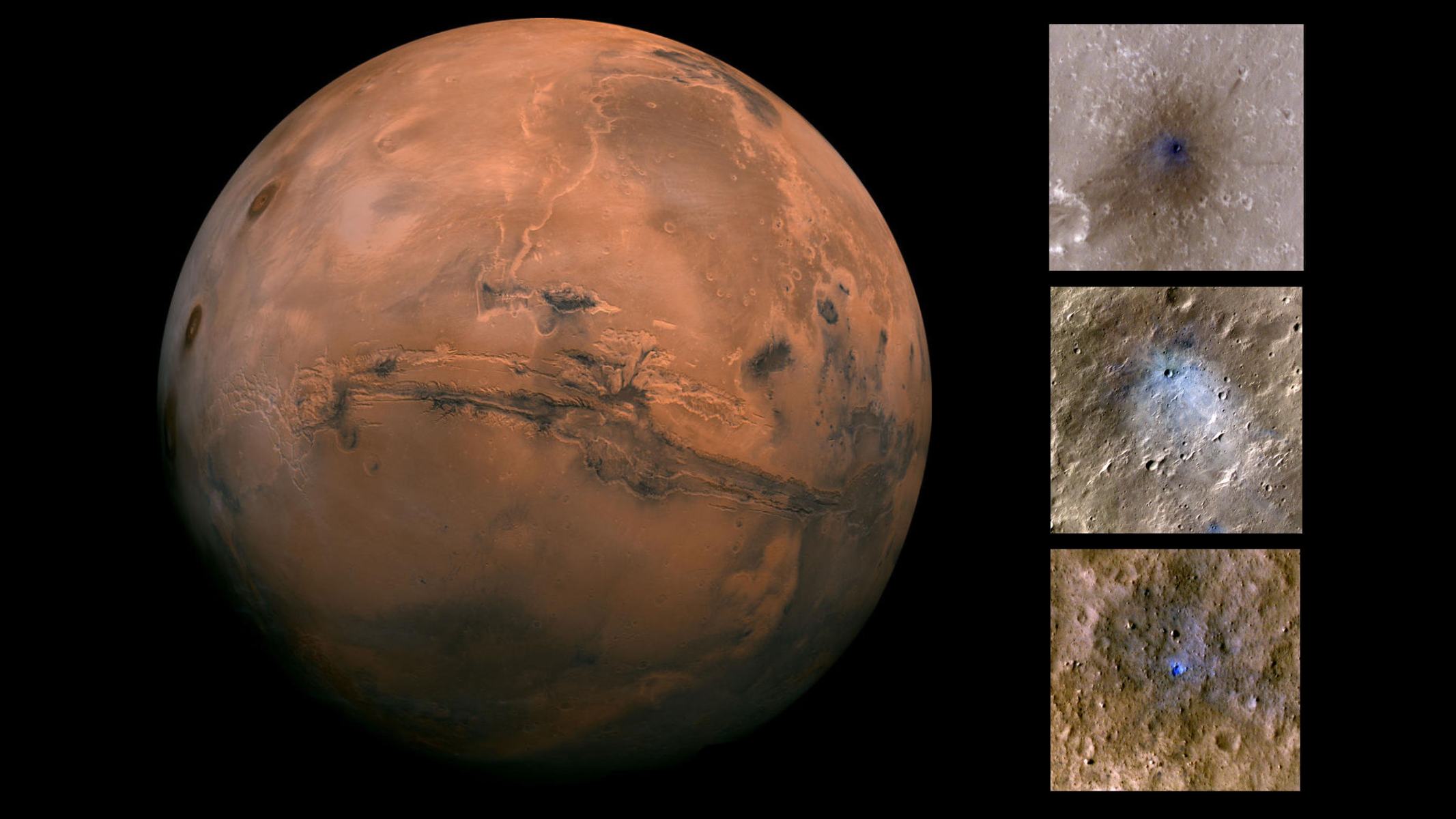NASA's Mars lander hears the 'bloop' of meteorites hitting the Red Planet
The Martian lander has been looking for seismic and acoustic waves from impacts since 2018.
The Mars InSight lander has detected seismic and acoustic waves created when four space rocks impacted the surface of the Red Planet.
InSight's seismometer felt the vibrations from the impacts in 2020 and 2021, marking the first detections of meteoroids hitting the planet since the lander began gathering data after touching down in 2018. The meteoroid impacts occurred between 53 miles (85 kilometers) and 180 miles (290 km) from InSight's location in the Elysium Planitia region of Mars, a broad plain that stretches across the Martian equator.
One of the space rocks, the first that scientists detected, made a dramatic and violent entrance on Sept. 5, 2021, exploding into pieces. At least three separate fragments struck the Martian surface, each leaving a crater.
Related: NASA's InSight Mars lander spotted from orbit, covered in dust

NASA's Mars Reconnaissance Orbiter (MRO) confirmed the location of these impacts from orbit. The spacecraft, which launched in 2005, initially took black and white images of the regions with its Context Camera, revealing dark patches on the Martian surface. After pinpointing these impact sites, MRO followed up by collecting color images and close-ups using its High-Resolution Imaging Science Experiment camera (HiRISE). The meteoroids may have left additional craters around these impact sites that are too small for even HiRISE to spot.
Searching through earlier data collected by InSight revealed that the lander's seismometer had already picked up three previous impacts on May 27, 2020, and Feb. 18 and Aug. 31, 2021. The four impacts produced small marsquakes with a magnitude of no more than 2.0.
"After three years of InSight waiting to detect an impact, those craters looked beautiful," Ingrid Daubar, a planetary scientist at Brown University in Rhode Island and part of the team that made the discovery, said in a statement.
Get the Space.com Newsletter
Breaking space news, the latest updates on rocket launches, skywatching events and more!
Why so few impacts?
Planetary scientists are confused as to why InSight hasn't detected more space rock impacts on the Red Planet. Not only does Mars sit next to the solar system's main asteroid belt, a hotspot for space rocks, but its thin atmosphere should allow meteoroids to pass through it without destroying them. These factors mean that a higher proportion of space rocks should make it to the Martian surface than, say, Earth's.
Researchers have been fairly confident that the lack of detections isn't a sign that InSight's seismometer is flawed. In its nearly four years on the Red Planet, the instrument has detected more than 1,300 marsquakes and has been sensitive enough to detect seismic waves from thousands of miles away.
InSight scientists had thought impacts might be hidden by noise from the wind on the Red Planet or by seasonal changes in the atmosphere. Researchers will now revisit InSight data to search for the seismic fingerprints of other space rock impacts.

Any such impacts they find could help scientists better understand the age of the Martian surface. Counting impact craters is one way that scientists date the age of a planet's surface, meaning the new discovery and any additional impacts could be vital in building a timeline for Mars.
"Impacts are the clocks of the solar system," Raphael Garcia, a planetary scientist at the Institut Supérieur de l'Aéronautique et de l'Espace in France and lead author on the new research, said in the same statement. "We need to know the impact rate today to estimate the age of different surfaces."
By combining InSight data regarding the shockwaves created when space rocks hit the atmosphere with data collected from orbit, scientists may also be able to reconstruct the incoming trajectory of a specific meteoroid.
"We're learning more about the impact process itself," Garcia said. "We can match different sizes of craters to specific seismic and acoustic waves now."
And researchers have a little bit more time to collect data with InSight than they'd thought. Dust build-up on the lander's solar panels is reducing its power supply and will eventually force it to shut down; previous estimates suggested this would occur in late summer, but now mission personnel think it won't happen until between October 2022 and January 2023.
A paper detailing InSight's findings was published Monday (Sept. 19) in the journal Nature Geoscience.
Follow us on Twitter @Spacedotcom and on Facebook.
Join our Space Forums to keep talking space on the latest missions, night sky and more! And if you have a news tip, correction or comment, let us know at: community@space.com.

Robert Lea is a science journalist in the U.K. whose articles have been published in Physics World, New Scientist, Astronomy Magazine, All About Space, Newsweek and ZME Science. He also writes about science communication for Elsevier and the European Journal of Physics. Rob holds a bachelor of science degree in physics and astronomy from the U.K.’s Open University. Follow him on Twitter @sciencef1rst.









